|
| | BIOGRAFIE,
ARTICOLI, COMMENTI TROVATI IN RETE SU FRIDA KAHLO
(prossimo
articolo)
Frida
Kahlo was a Mexican painter, born on July 6, 1907 and dead on July 13, 1954.
Frida
claimed to be born on 1910, the year of the outbreak of the Mexican revolution,
because she wanted her life began together with the modern Mexico.
This
detail well introduces us to a singular personality, characterized since her
childhood by a deep sense of independence and rebellion against social and moral
ordinary habits, moved by passion and sensuality, proud of her "Mexicanidad"
and cultural tradition set against the reigning Americanization: everything
mixed with a peculiar sense of humour.
Her life was marked by physical suffering, started with the polio contracted at
the age of five and worsen by her life-dominating event occurred in 1925. A bus
accident caused severe injuries to her body owing to a pole that pierced her
from the stomach to the pelvis. The medicine of her time tortured her body with
surgical operations (32 throughout her life), corsets of different kinds and
mechanical "stretching" systems.
Lots of her works were painted laying in the bed. Because of these physical
conditions Frida was never able to have any children and this was a great sorrow
for her.
She had a great love, Diego Rivera (she married twice with this man and
dedicated to him a passionate diary) but also a lot of lovers, men and women,
such as Leon Trotsky and André Breton's wife....
It is impossible to sum up with few lines the complexity and the charm of Frida's
life. It is advisable to read one of her numerous biographies (personally I
suggest "FRIDA. A Biography of Frida Kahlo" by Hayden Herrera, Harper
& Row).
(prossimo
articolo torna
all'inizio)
Frida Kahlo
was a painter whose work fascinated prominent and diverse artists around the
world. The wife of world-renowned Mexican muralist Diego Rivera, Kahlo forged a
place in the art world that was completely of her own. Her dramatic work
consisted primarily of self-portraits, although she did capture her family and
friends on canvas on occasion. Some critics contend that Kahlo's paintings were
reflections of her personal history, her relationship with Diego Rivera; her
damaged physical condition, her philosophy of nature and life, and her
individual and mythological worldview. Although Kahlo never had formal training
in art, she developed into an artist who fascinated wide range of fellow artist,
including Soviet filmmaker Sergei Eisenstein, painter Pablo Picasso, and
novelist Andre Breton. In addition to these literary and artistic luminaries,
her circle included political figures such as Leon Trotsky and the Rockefeller
family.
Frida
Kahlo lived between 1907 and 1954 in a time of incredible worldwide movements
and changes. The Mexican Revolution occurred just three years after she was born,
a development that triggered dramatic social and economic change in Mexico. A
new sense of nationalism surged throughout Mexico as the people rejected
dictator Porfirio Diaz and his policies, and a renaissance of cultural renewal
glorifying Mexico's native roots took place. The Mexican muralist tradition grew
out of these changes and proved to be an enduring method of expressing national
pride. Kahlo was an active participant in the social, economic and political
landscape that characterized that life. Frida Kahlo was born Magdalena Carmen
Frieda Kahlo y Calderon on July 6, 1907, in her parents' house in Coyoacan,
Mexico a suburb of Mexico City.
In
about 1935 she dropped the "e" in her first name. Her father one of
Mexico's foremost photographers, was the son of Hungarian Jews from the German
town of Baden-Baden who emigrated to Mexico. Guillermo Kahlo married her mother
Matilde Calderon, a Mexican of Indian and Spanish ancestry. The family home,
called the Casa Azul ("Blue House"), was built by Guillermo Kahlo a
few years before Frida's birth. She was born, raised, lived and died in her
family's home. Kahlo's father had a profound influence on her life. Her mother
was a meticulous housekeeper and devout catholic whose conventional patterns of
thought created some distance between her and her daughters. Kahlo's father, on
the other hand, recognized and encouraged her intellectual independence and
curiosity.
At
the age of seven, Kahlo was afflicted with polio, a disease that left her right
foot turned outward and stunted the growth of her entire right leg. Her father
nursed her back to health and subsequently encouraged her to play various active
sports not typical for a Mexican girl at that time. Kahlo's bout with polio held
her back in school, so in 1922, when she entered the National preparatory School,
she falsified her age. Some historians have speculated that she chose 1910 as
her birth date to coincide with the year of the Mexican Revolution started.
Kahlo was adamant in her commitment to ideals of revolution. She expressed her
bond to the Mexican people in her art, in her dress, her behavior, and the
decorations of her home. During her days at the National Preparatory School,
Kahlo became known as something of a prankster and was a highly visible presence.
She often wore elaborate indigenous jewelry and colorful native clothing, and
was fond of piling her hair upon her head and decorating brightly with ribbons
and bows in the fashion that the natives of Oaxaca, Mexico, favored Kahlo
regarded every occasion as a cause for rejoicing, and celebrated birthdays,
baptisms, and all the popular holidays with great enthusiasm.
It
was at the National Preparatory School that she first met Diego Rivera, an
artist whose work she admired. Her attraction to the painter was considerable,
and one story from that period of her life alleged that she declared to her
school friends her ambition to have a child by Diego Rivera. In 1925, however,
Kahlo was involved in a tragic accident that dramatically changed her life.
Traveling home from school on a bus, the vehicle collided with a trolley car,
driving a piece of iron into her pelvis an back. Kahlo struggled with the
effects of this accident and the pain it caused for the rest of her life. She
underwent as many as 35 operations over the course of her life, most of them on
her spine and her polio-deformed right foot.
It
was during Kahlo's convalescence from the bus accident that she began painting.
Kahlo was required to spend long periods of time flat on her back in bed, so her
mother bought her a special easel that she could use despite her physical
limitations. She began to express her explosive feelings trough painting.
Kahlo
never returned to school after her release from the hospital. Instead, she
concentrated on her painting. About this time, she met the Italian-born American
photographer Tina Modotti. It was through her friendship with Modotti that Kahlo
was introduced to an exciting new sphere of art and leftist politics. Diego
Rivera was a member of this circle, and he and Kahlo soon became involved. Kahlo
joined the Young Communist league, an organization that Rivera founded and led
the 22 year old Kahlo married the 42 year old Rivera in a a civil ceremony in
1929.
The
marriage proved to be a tumultuous one. Kahlo lamented that she suffered through
two accidents in her life; one was the trolley car incident, the other her
marriage to Rivera. Both had extramarital affairs, and several of Kahlo's
relationships were with other women. Kahlo and Rivera separated for a long time,
divorced, and eventually remarried. All during their stormy association, however,
they served as the hub of an international intellectual circle. Their political
activism continued, unaffected by the state of their marriage, as both Kahlo and
Rivera used their artistic talents to express their social and political views.
In
1938 Andre Brenton visited her in Mexico and remarked that she was a surrealist.
Kahlo disagreed, arguing that she painted her reality. She did, however, travel
to Europe and New York to show her work in a surrealist exhibitions. Later, she
firmly rejected the surrealist label, contending that her work dissolved the
distinctions between reality and fantasy.
In
the 1940s Kahlo taught art, her students became known as Los Fridos. Although
her students spent a lot of time with her at home, in her studio, an out in the
streets, they never saw her paint. She painted alone, a practice that led some
critics and friends to describe her paintings as a form of therapy.
Kahlo's
marriage to Rivera was but one of the difficulties she grappled with during her
adulthood. She suffered numerous miscarriages that caused her great grief. In
addition, the injuries suffered in the bus accident continued to hound her,
relegating her to her bed for months at a time and keeping her in a state of
almost constant pain. Finally, in 1953, her right leg was amputated to gangrene.
Throughout all of these difficulties, Kahlo continued to paint. She became
addicted to the medicine prescribed for pain. Despite her failing body, Kahlo
endeavored to maintain the old ways of gaiety, excitement and drama.
Her
last public appearance was at a demonstration protesting C.I.A. intervention in
the overthrow of leftist President Jacobo Arbenz of Guatemala. She died seven
days later on July 13, 1954, at the age of 47.
Dictionary of Hispanic Biography by Joseph C. Tardiff, L. Mpho Mabunda
Biography by Las Mujeres: Frida Kahlo
(prossimo
articolo torna
all'inizio)
There
is a moment in the early life of
Frida Kahlo
that uniquely illumines the evolution of her myth. It is not one of her many
luckless moments - not her childhood contraction of polio, nor the bus accident
that fractured her skeleton and left her in unremitting pain, nor any of the
more than 30 operations that followed; it is not even her first, ill-omened
glimpse of Diego Rivera, the great painter who married her and then deceived her
at every opportunity. It is the moment, apparently sometime in her 18th year,
when, gazing into the mirror, she decided to stop trimming her eyebrows - to let
those two sumptuous pieces of fur grow into one. It is when she found, you might
say, the pluck to not pluck - a decision she would never regret. For those
eyebrows made possible the Cult of Kahlo: they were the providential
precondition of her celebrity.
Of
all our 20th-century icons, Frida Kahlo is the only one whose business it was
literally to create icons, votive pictures of herself. Such images have to lend
themselves to instant recognition, and that is what her eyebrows afforded. They
perched upon her brow, as Rivera used to say, like a blackbird's outspread wings.
They were a banner, a blazon.
At
her death, in 1953, Kahlo was regarded as a marginal figure. Since then, her
fame has steadily risen. In 1977, the first of her pictures sold at auction
fetched $19,000, but by 1995 a self-portrait brought in $3.2 million, the
highest sum ever bid for a painting made south of the border. By now, like
Georgia O'Keeffe and Botero and Andrew Wyeth, she has entered the dubious
demimonde of "beloved" painters. Kahlo's worldwide constituency is
composed not only of Mexicans and other Latinos but also of art students,
leftists, feminists, the genuinely ill, the merely miserable - anyone who can
identify with her tale of grief and grit.
If
Kahlo hadn't created her self-devotional icons, nobody would notice her today.
Yet these tediously rendered images are portraiture at its least imaginative;
her best work consists of her pictures of other people and her still lifes.
Folkloric painters often feel pledged to extreme representational fidelity, but
Kahlo's literal-mindedness was as confining as one of her orthopedic corsets. To
convey unhappy feelings, she painted herself weeping. To project her physical
suffering, she showed herself bleeding or with a pole slammed through her body.
Death is indicated by corpses. And because she had almost no sense that paint is
a metaphorical and not a literal medium, most talk about her pictures rapidly
turns into an exercise in biographical reference hunting: her explicators sound
as if they're translating glyphs or solving a rebus.
For
some it may be tempting to condescend to Frida's fans. However - and I say this
as something of a fan myself - this impulse should be resisted. If Kahlo's life
often seems a prolonged lesson in the uses of hysteria, some of those uses turn
out to have been rather exhilarating. Her best paintings, like "El
Defuntito Dimas Rosas" or "Do–a Rosita Morillo," are nothing to
sneeze at. She was terrifically photogenic and helped reveal the international
fashion potential of Latin women. She designed one of the world's most buoyantly
expressive rooms, the kitchen of her Casa Azul, in Coyoacýn. She is also, like
very few of her contemporaries, a peculiarly illustrative historical figure, a
key to an entire generation of Mexican artists.
In
her fascinating biography "Frida," Hayden Herrera tells us that Kahlo
was "never maudlin or self-pitying." But maudlin and self-pitying is
just what she almost always was, and though her self-pity itself is boring, her
willingness to break the taboo against it was a stroke of genius. "So you
can't make art out of feeling sorry for yourself?" she seems to be saying.
"Watch me." This, of course, is the secret of her success. For
millions of people the world over, what, after all, is art, what has it ever
been, if not a license to tell all your sorrows, to force people to look at you,
to spill out your guts on stage? Of these multitudes, Frida Kahlo is the patron
saint.
Dan Hofstadter is the author of "The Love Affair as a Work of Art."
(prossimo
articolo torna
all'inizio)
The
New York Time Magazine: an article written on July
13, 1954 - the day of Frida's death
Wednesday,
July 14, 1954
Frida
Kahlo, Artist, Diego Rivera's Wife
MEXICO CITY, July 13 -- Frida Kahlo, wife of Diego
Rivera, the noted painter, was found dead in her home today. Her age was 44. She
had been suffering from cancer for several years.
She
also was a painter and also had been active in leftist causes. She made her last
public appearance in a wheel chair at a meeting here in support of the new
ousted regime of Communist-backed President Jacobo Arbenz Guzman of Guatemala.
Frida
Kahlo began painting in 1926 while obliged to lie in bed during convalescence
from injuries suffered in a bus accident. Not long afterward she showed her work
to Diego Rivera, who advised, "go on painting." They were married in
1929, began living apart in 1939, were reunited in 1941.
Usually
classed as a surrealist, the artist had no special explanation for her methods.
She said only: "I put on the canvas whatever comes into my mind." She
gave one-woman shows in Mexico City, New York and elsewhere and is said to have
been the first woman artist to sell a picture to the Louvre.
Some
of her pictures shocked beholders. One showed her with her hands cut off, a huge
bleeding heart on the ground nearby, and on either side of her an empty dress.
This was supposed to reveal how she felt when her husband went off alone on a
trip. Another self-portrait presented the artist as a wounded deer, still
carrying the shafts of nine arrows.
A
year ago, too weak to stand for more than ten minutes, she sat daily at her
easel, declaring: "I am happy to be alive as long as I can paint."
(prossimo
articolo torna
all'inizio)



 | Ades,
Dawn. Art in Latin America: The Modern Era, 1920-1980. New Haven and
London: Yale University Press, 1989.
|
 | Alcantara,
Isabel - Egnolf, Sandra.Frida Kahlo and Diego Rivera, International
Book Import Service, Inc., September 1999 |
 | Anderson
Jones, Jane. Frida Kahlo (Rourke Biographies the Arts). Rourke Pub
Group, September 1993. |
 | Artes
de Mexico [Mexico City] 198 (1960). Issue titled "Monjas Coronadas".
Various authors. English translations: 95-109. |
 | Ashton,
Dore. Surrealism and Latina America, in Latin American Artists of the
Twentieth Century. Museum of Modern Art and Harry N. Abrahams Inc., New York
1993, pp.106-15. |
 | Baddeley,
Oriana, and Valerie Fraser. Drawing the Line: Art and Cultural Identity
In Contemporary Latin America. London and New York: Verso, New Left
Books, published in association with the Latin American Bureau, 1989. |
 | Ballinger,
James K.Frida Kahlo, Diego Rivera, and Twentieth Century Mexican Art: The
Jacques and Natasha Gelman Collection . Museum of Contemporary Art,
August 2000. |
 | Bartra, Eli. Mujer, ideología y arta.
Ideología y política en Frida Kahlo y Diego
Rivera. Barcelona: La Sal, Ediciones de les Dones,
1987. |
 | Billeter,
Erica (Editor). The World of Frida Kahlo : The Blue House. Published
by Museum of Fine Arts Houston, January 1, 1994. |
 | Brenner,
Anita. Idols Behind Altars. New York, Payson & Clarke, 1929. |
 | Breton,
André. Surrealism and Painting. Trans. Simon Watson Taylor. New
York: Harper & Row, Publishers, 1972. Italian
translation: Breton, André. Il surrealismo e la pittura, 1928-1965. Firenze,
Marchi & Bertolli, 1966. |
 | Chadwick,
Whitney. Women Artists and the Surrealist Movement. Boston: Little, Brown
and Company,1985. |
 | Charlot,
Jean. The Mexican Mural Renaissance: 1920-1925. New Haven and London:
Yale University Press, 1967. |
 | Clifford,
James. The Predicament of Culture: Twentieth Century Ethnography,
Literature, and Art. See especially: "Histories of the Tribal and
the Modern," (189-214) and "On Ethnographic Surrealism ,"
(117-151). Cambridge: Harvard University Press,1988. |
 | Cruz,
Barbara. Frida Kahlo: Portrait of a Mexican Painter (Hispanic
Biographies). Enslow Pub., August 1, 1996. |
 | Cullen,
Greg.Mary Morgan / Tarzanne / Frida and Diego Dufour Editions.,January
1998 |
 | del Conde, Teresa. Vida de Frida Kahlo.
Mexico City: Secretaría de la Presidencia, Departamento Editorial, 1976. |
 | Dromundo, Baltasar. Mi Calle de San
Idelfonso. Mexico City: Editorial Guarania, 1956.
|
 | Drucker,
Malka. Frida Kahlo. University of New Mexico
Press, 1995. |
 | Drucker,
Malka. Frida Kahlo: Torment and Triumph in Her Life and Art (The Barnard
Biography Series). Out of print.
|
 | Durán,
Fray Diego. Book of the Gods and Rites and the Ancient Calendar.
Translated and edited by Fernando Horcasitas and Doris Heyden. Norman:
University of Oklahoma Press, 1971. |
 | Flores
Guerrero, Raùl. Cinco Pintores Mexicanos. Mexico City: Universidad
Nacional Autónoma de México, 1957. |
 | Foster,
Hal. Recodings, Art, Spectacle, Cultural Politics. See especially:
"The 'Primitive' Unconscious of Modern Art, or White Skin Black Masks,"
(181-208) Port Townsend, Washington: Bay Press,1985. |
 | Franco,
Jean. Plotting Women: Gender and Representation in Mexico. New York:
Columbia University Press, 1989. |
 | Frazier,
Nancy. Frida Kahlo : Mysterious Painter (The Library of Famous Women).
Blackbirch Marketing, June 1994. |
 | Fuentes,
Carlo and Lowe Sarah M. The Diary of Frida Kahlo: An Intimate
Self-portrait. Harry N. Abrams Inc., New York, 1995. Italian
translation: Frida Kahlo: autoritratto intimo, Leonardo, 1995. |
 | Fuentes,
Carlos and Sarah Lowe. The Diary of Frida Kahlo: An Intimate
Self-Portrait. Harry N. Abrams Inc., April 1998.
|
 | Fuentes,
Carlos. The Years with Laura Diaz. Farrar Straus & Giroux,
October 2000.
|
 | Garcia,
Rupert. Frida Kahlo: A Bibliography and Biographic Introduction.
Berkeley: University of California, Chicano Studies Library Publications
Unit,1983. |
 | Garza,
Hedda. Frida Kahlo (Hispanics of Achievement). Chelsea House Pub,
1993.
|
 | Garza,
Hedda and Robert Green. Frida Kahlo (Hispanics of Achievement).
Chelsea House Pub, 1993.
|
 | Gruening,
Ernest. Mexico and Its Heritage. New York: Appleton-Century-Crofts,
1928.
|
 | Grimberg,
Salomon. Frida Kahlo. Dallas: The Meadows Museum, Southern Methodist
University, 1989. |
 | Hardin,
Terri. Frida Kahlo: A modern Master (Art Series). Out of print.
|
 | Heijenoort,
Jean van. With Trotsky in Exile: From Prinkipo to Coyoacan.
Cambridge, Mass., and London: Harvard University Press, 1978. |
 | Helm,
MacKinley. Modern Mexican Painters. New York: Dover, 1968. |
 | Henestrosa, Andrés. Una Alacena de
Alacenas. Mexico City: Ediciones de Bellas Artes,
1970. |
 | Herrera,
Hayden. Frida: A Biography of Frida Kahlo. New York: Harper & Row,
1983. Italian
translation: Frida: Vita di Frida Kahlo, La Tartaruga edizioni,
Milano 1993. |
 | Herrera,
Hayden. Frida Kahlo: The Paintings. Harper Collins, New York 1991. |
 | Herrera,
Hayden. Frida Kahlo (Rizzoli Art Series). Rizzoli Intl Pubns,
November 1992. |
 | Herrera,
Juan Felipe. The Roots of a Thousand Embraces: Dialogues. Manic d Pr,
August 1994. |
 | Kahlo,
Frida and Salomon Grimberg. Lola Alvarex Bravo: The Frida Kahlo
Photographs. Distributed Art Pub (Dap), March 1992. |
 | Kahlo,
Frida. Frida Kahlo : Masterpieces (Schirmer's Visual Library). W W
Norton & Co, December 1994. |
 | Kahlo,
Frida and Martha Zamora (Editor). The Letters of Frida Kahlo: Cartas
Apasionadas. Chronicle Books, 1995.
|
 | Kettenmann,
Andrea. Frida Kahlo 1907-1954: Pain and Passion. Benedikt Taschen, 1993. |
 | Kuenster,
Ken. Frida Kahlo,
Creative Arts Book Company, September 1999. |
 | Le Clezio, J - M.G.. Diego et Frida, out of print. |
 | Lafaye,
Jacques. Quetzalcóatl and Guadalupe: The Formation of Mexican Natlonal
Consciousness 1531-1813. Translated by Benjamin Keen. Chicago and London:
University of Chicago Press, 1976. |
 | Lindauer,
Margaret A. and Frida Kahlo. Devouring Frida: The Art History and Popular
Celebrity of Frida Kahlo. Wesleyan Univ. Pr., April 1999.
|
 | Lowe,
Sarah M. Frida Kahlo. Universe, New York 1991. |
 | Marin
Rivera, Guadalupe and Marie-Pierre Colle. Frida's Fiestas : Recipes and
Reminiscences of Life With Frida Kahlo. Clarkson Potter, October 1,
1994. |
 | Milner,
Frank.Frida Kahlo. Smithmark Publishing,
August 1995. |
 | Moffeit,
Tony. Billy the Kid & Frida Kahlo. Paperback June 23, 2000. |
 | Montana
Turner, Robyn. Frida Kahlo (Portraits of Women Artists for Children).
Little Brown & Co (Juv Trd), April 1, 1993. |
 | Mulvey,
Laura, and Peter Wollen. Frida Kahlo and Tina Modotti.
London: Whitechapel Art Gallery,1982. |
 | Oles,
James. Frida Kahlo, Diego Rivera, and Mexican modernism: from the Jacques
and Natasha Gelman collection. Out of print.
|
 | Paz,
Octavio. The Labyrinth of Solitude: Life and Thought in Mexico.
Translated by Lysander Kemp. New York: Grove, 1961.
|
 | Poniatowska, Elena and Carla Stellweg .
Frida Kahlo: The Camera Seduced. Chronicle Books, San Francisco, 1992. |
 | Prignitz-Poda,
Helga, Salomón Grimberg and Andrea Kettenmann. Frida Kahlo. Das
Gesamtwerk, Verlag Neue Kritik FG, Frankfurt am Main 1988. |
 | Rauda, Jamis. Frida Kahlo.
Editorial Diana Sa, 1998. |
 | Richmond,
Robin. Frida Kahlo in Mexico (Painters and Places Series). Pomegranate,
May 1, 1994. |
 | Rivera,
Diego, with March, Gladys. My Art, My Life: An Autobiography. New
York: Citadel, 1960. |
 | Rodríguez Prampolini, Ida. El
Surrealismo y el Arte Fantóstico de México. Mexico City: Instituto de
Investigaciónes Estéticas, Universidad Nacional Autónoma de Mexico, 1969. |
 | Rothenstein, Julian, ed. Posada. Message of Mortality. London: Redstone Press, in
association with the South Bank Centre, 1989. |
 | Rummel,
Jack. Frida Kahlo: A Spiritual Biography . Crossroad Pub Co, June
2000. |
 | Sills,
Leslie.Inspirations: Stories about Women Artists: Georgia O'Keeffe, Frida
Kahlo, Alice Neel, Faith Ringgold, Albert Whitman, November 1998. |
 | Schmeckebier,
Laurence E. Modern Mexican Art. Minneapolis:
University of Minnesota Press, 1939. |
 | Tibol
, Raquel. Frida Kahlo : An Open Life. Translated by Elinor Randall.
University of New Mexico Press, 1993. |
 | Tibol, Raquel. Frida Kahlo. Translated by Helga Prignitz. Frankfurt:
Verlag Neue Kritik, 1980. |
 | Tibol, Raquel. Frida Kahlo: Crónica,
Testimonios y Aproximaciones. Mexico
City: Ediciones de Cultura Popular, S.A., 1977. |
 | Toor,
Frances. A Treasury of Mexican Folkways. New York: Bonanza Books,
1985 (Originally published by Crown Publishers, 1947).
|
 | Toussaint,
Manuel. Colonial Art in Mexico. Translated and edited by Elizabeth
Wilder Weismann. Austin and London: University of Texas Press, 1967. |
 | Trotsky,
Leon. Writings of Leon Trotsky: 1936-1937 and 1938-1939. 12 volumes
covering 1929-1940. Ed. Naomi Allen and George Breitman. New York:
Pathfinder, 1969-1975. |
 | Venezia,
Mike. Frida Kahlo (Getting to Know the World's Greatest Artists).
Children's Press, 1999.
|
 | Westheim,
Paul. The Art of Ancient Mexico. Trans. by Ursula Bernard. New York:
Doubleday (Anchor), 1965. |
 | Wolfe,
Bertram D. Diego Rivera: His Life and Times. New York and London:
Knopf, 1939. |
 | Wolfe,
Bertram D. The Fabulous Life of Diego Rivera. New York: Stein and
Day,1963. |
 | Wolfe,
Bertram D., and Rivera, Diego. Portrait of Mexico. Text by Bertram D.
Wolfe. Illustrated with paintings by Diego Rivera. New York: Covici, Friede,
1937. |
 | Zamora,
Martha. Frida Kahlo: The Brush of Anguish. San Francisco, Chronicle
Books, 1990. |
 | Zamora,
Martha. Frida Kahlo: I Painted My Own Reality (Artboxes). San
Francisco, Chronicle Books, 1995. |
(prossimo
articolo torna
all'inizio)
Frida
Kahlo e il Teatro
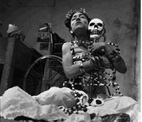 "Frida K" "Frida K"
monologue written by Gloria Montero
performed by Allegra Fulton
Monologue in one long act by Gloria Montero, first performed at the
Toronto Fringe Festival in 1994; subsequently reworked and performed at
Tarragon Theatre in 1995. It featured Allegra Fulton, was directed by
Peter Hinton, sets and costumes by Ken Garnhum, lighting by Bonnie Beecher.
Subsequently translated into Spanish, it has also played in Madrid and
Barcelona. The play may prove to be a work seminal in post-feminist
theatre as it veers away from many trends of early feminist theatre (victimization,
wariness of men, strong Lesbian through-lines) and presents a whole person
- rather than a message - who also happens to be a fascinating figure in
art history. The work is about the noted artist and diarist Frida Kahlo.
It succeeds on about a dozen levels; not simply as a cogitation on
womanhood, but as a magnificent journey through the world of art, a
discussion of Third and First World values and culture and as an anomalous
love story (Kahlo was married to muralist Diego Rivera). Even the staging
Montero suggests is interesting so that here we have a finished play; not
a work-in-progress, not a Fringe Fest monologue, not a too-intimate (and
therefore incomprehensible) spoken word diatribe. Kahlo merely talks, but
the possibilities for staging - beyond what Montero suggests - are endless,
especially given the interest in Kahlo's wonderfully weird and wildly
illustrated diaries. Montero wrote the work for her daughter, Allegra
Fulton, who played it all the way to a Dora Mavor Moore Award. The play
itself was also nominated for a Chalmers Award.
http://www.canadiantheatre.com/m/monterog.html
A review by LISA WILTON -- Calgary Sun
http://www.canoe.ca/TheatreReviewsF/friedak.html
|
"Frida
K"
di Gloria Montero
interpretato da Allegra Fulton
Monologo in un unico atto scritto da Gloria Montero, messo in scena per la
prima volta al Toronto Fringe Festival del 1994 e replicato al Teatro di
Tarragona nel 1995. Interpretato da Allegra Fulton, diretto da Peter
Hinton, con scenografia e costumi di Ken Garnhum, luci di Bonnie Beecher.
Successivamente è stato tradotto in spagnolo e messo in scena a Madrid e
Barcellona.
Questo lavoro è considerato di grande rilievo nell'ambito del teatro
post-femminista, in quanto segna un cambiamento di rotta rispetto
all'approccio del teatro femminista precedente (vittimizzazione,
diffidenza verso gli uomini, forte atteggiamento lesbico) grazie alla
presentazione di un personaggio nella sua globalità - piuttosto che come
veicolo di un messaggio - che si dà il caso sia stato una figura
affascinante della storia dell'arte.
L'opera presenta l'artista Frida Kahlo procedendo su vari livelli. Non è
solo una semplice riflessione sulla condizione della donna, ma al contempo
un magnifico viaggio nel mondo dell'arte, una discussione sui valori e
sulla cultura del Terzo e Primo Mondo e un'anomala storia d'amore (Frida e
il muralista Diego Rivera).
La stessa Montero definisce interessante "Frida K" per la sua
caratteristica di opera compiuta, non un work-in-progress, non un monologo
da Fringe Fest, non una diatriba intimista di parole parlate (perciò
incomprensibile). Frida Kahlo semplicemente parla, ma le potenzialità
della sua presenza sulla scena - al di là di quello che le parole della
Montero suggeriscono - sono infinite, considerato soprattutto il
riferimento allo strano e selvaggio diario di Frida, meravigliosamente
illustrato.
Gloria Montero ha scritto quest'opera per sua figlia Allegra Fulton, che
ha ricevuto il premio "Dora Mavor Moore Award" per la sua
interpretazione. Lo stesso monologo è stato nominato per il premio "Chalmers
Award".
|
 OPERA OPERA
"Yo soi la desintegration"
9th September 1997
"Théatre de l'Espace Go"
Montreal
The Montreal soprano Pauline Vaillancourt and her "Chants Libres"
company created in 1997 a multimedia opera titled "Yo soi la
desintegration", inspired by Frida Khalo's diary.
After reading the diary and obsessed by Frida' s personality, Pauline
Vaillancourt decided to dedicate her new lyric work to Frida and declared:
"Since the first pages I realized that it was a perfect sound-visual
subject. Furthermore Frida is a great artist, unfortunately not so known
in the Francophone ambient, and I hope my performance will help her
discovery". "Yo soi la desintegration" was one of the
biennial productions of the "Chants Libres" company, usually
performed by a single actor on stage. This experimental formula allows the
company to produce less heavy works and to use multimedia tools, usually
not expected in the world of opera.
The artistic director would like to precise that "Yo soi la
desintegration" is not the tale of Frida' s life, but a complete
transposition to create a metaphor valid as a lesson for life. The
autobiographical material was transformed, recycled and reconstructed to
create a woman personality incarnated by Pauline Vaillancourt, used to
giving life to women animated by a nearly superhuman vital energy.
The music was composed by Jean Pichée, professor at the Faculty of Music
of the Montreal University, while the writing of the libretto was
entrusted to Yan Muckle. The stage and costume designing, together with
the video material, was realized by Anita Pantin, painter, stage and
multimedia designer.
In the introduction the project is described in this way: "The opera
shows the story of a woman, her struggle against pain after the accident
that marked her life, her encounter with love and treason, her days of
loneliness, her constant living close to death. It shows the inner and
vital drama of a woman that tries with all her strengths to love, create
and live". The performance is also defined "sweet and hard,
tender and cruel, dark and coloured, overpowering and damped".
 Pauline Vaillancourt finally adds that this
opera talks about destiny, the one that marked Frida and also that
afflicting all the people tried by misfortune. "The opera asks a
fundamental question: what one can do with his life when destiny seems to
decide on his behalf. Frida suffered the consequences of the youth
accident during all her life. Obviously she had not decided to take this
trial, but she managed to accept it and to overcome it, like all people
surviving wars, hunger, personal and collective tragedies, everything that
cannot be controlled by us but must not control us. Frida's life was an
exceptional life thanks to her courage: her lived existence is a lesson of
hope". Pauline Vaillancourt finally adds that this
opera talks about destiny, the one that marked Frida and also that
afflicting all the people tried by misfortune. "The opera asks a
fundamental question: what one can do with his life when destiny seems to
decide on his behalf. Frida suffered the consequences of the youth
accident during all her life. Obviously she had not decided to take this
trial, but she managed to accept it and to overcome it, like all people
surviving wars, hunger, personal and collective tragedies, everything that
cannot be controlled by us but must not control us. Frida's life was an
exceptional life thanks to her courage: her lived existence is a lesson of
hope".
The soprano underlines again: "I did not try to tell a story. The
opera was conceived as a combination of eight scenes corresponding to
different phases of Frida's life, from childhood to death, with the
central event of the accident. After having accepted her new constraints,
the heroine enjoined again life and love, facing also their cruel side
such as lies and malice, till her death. This metaphor was sang in Spanish
and above all in French. The scene design was inspired by Frida's
environment but also in this respect it is better to talk about a
transposition: "It is not a comedy" Pauline Vaillancourt sums
up.
|
OPERA
"Yo soi la desintegration"
9 settembre 1997
"Théatre de l'Espace Go" Montréal.
La soprano di Montréal Pauline Vaillancourt e la sua compagnia Chants
Libres hanno creato nel 1997 un'opera multimediale dal titolo "Yo soi
la desintegration", ispirata al diario di Frida Kahlo.
Pauline Vaillancourt, ossessionata dal personaggio di Frida dopo averne
letto il diario, decise di farne il soggetto della sua nuova creazione
lirica e dichiarò:"Fin dalle prime pagine ho capito che avevo tra le
mani un soggetto che poteva essere molto sonoro e molto visuale. Inoltre
Frida è un'artista grandiosa, purtroppo ancora poco nota nell'ambiente
francofono e spero che il mio spettacolo contribuisca alla sua
scoperta".
 L'opera
dedicata a Frida rientra nelle produzioni biennali della compagnia Chants
Libres, dedicate in genere ad un unico personaggio e con un unico
intreprete sulla scena. E' una formula sperimentale che permette di
realizzare lavori meno pesanti di quelli tradizionali e di utilizzare
strumenti multimediali meno consueti nel mondo dell'opera lirica. L'opera
dedicata a Frida rientra nelle produzioni biennali della compagnia Chants
Libres, dedicate in genere ad un unico personaggio e con un unico
intreprete sulla scena. E' una formula sperimentale che permette di
realizzare lavori meno pesanti di quelli tradizionali e di utilizzare
strumenti multimediali meno consueti nel mondo dell'opera lirica.
La direttrice artistica tiene a precisare che "Yo soi la
desintegration" non è il racconto della storia di Frida Kahlo, ma
una trasposizione, l'ispirazione per una metafora valida come lezione di
vita. Il materiale autobiografico della pittrice è stato dunque
trasformato, riciclato, ricomposto per creare un personaggio di donna
incarnato da Pauline Vaillancourt, abituata a dare vita a personaggi
femminili animati da una forza vitale quasi sovrumana.
La musica di "Yo soi la desintegration" è stata composta da
Jean Pichée, professore aggregato della Facoltà di musica dell'Università
di Montreal, e la redazione del libretto è stata affidata a Yan Muckle.
La scenografia, i costumi e i video sono stati realizzati da Anita Pantin,
pittrice, scenografa e realizzatrice di film d'animazione computerizzata.
Nella presentazione del progetto è scritto:"L'opera illustra la
storia di una donna, la sua lotta contro il dolore in seguito ad un
incidente che ha sconvolto la sua vita, il suo incontro con l'amore e il
tradimento, i suoi giorni di solitudine, il suo coesistere costante con la
morte. Viene esposto il dramma intimo e vitale di una donna che cerca con
tutte le sue forze di amare, creare e vivere". Il lavoro viene anche
presentato come "uno spettacolo dolce e duro, tenero e crudele,
oscuro e colorato, travolgente e smorzato".
 Pauline
Vaillancourt aggiunge che questo spettacolo tratta infine il tema del
destino, quello che ha segnato Frida ma anche quello che affligge tutte le
persone provate dalla vita. "L'opera pone una domanda fondamentale:
cosa si può fare della propria vita quando il destino sembra decidere per
noi. Frida ha subito le conseguenze di un incidente di gioventù per tutta
la vita. Ovviamente non ha scelto di passare per questa prova. Ma alla
fine l'ha accettata, superata, come tutti coloro nel mondo che
sopravvivono alla fame, alla guerra, ai drammi personali e collettivi, a
tutto ciò che non si può controllare ma che non ci deve controllare.
Frida ha fatto della sua vita una vita d'eccezione grazie al suo coraggio.
La sua esistenza vissuta è una lezione di speranza." Pauline
Vaillancourt aggiunge che questo spettacolo tratta infine il tema del
destino, quello che ha segnato Frida ma anche quello che affligge tutte le
persone provate dalla vita. "L'opera pone una domanda fondamentale:
cosa si può fare della propria vita quando il destino sembra decidere per
noi. Frida ha subito le conseguenze di un incidente di gioventù per tutta
la vita. Ovviamente non ha scelto di passare per questa prova. Ma alla
fine l'ha accettata, superata, come tutti coloro nel mondo che
sopravvivono alla fame, alla guerra, ai drammi personali e collettivi, a
tutto ciò che non si può controllare ma che non ci deve controllare.
Frida ha fatto della sua vita una vita d'eccezione grazie al suo coraggio.
La sua esistenza vissuta è una lezione di speranza."
Precisa ancora la Vaillancourt "Non si cerca di raccontare una
storia. L'opera è stata concepita sotto forma di quadri, otto in totale,
che compongono altrettante fasi di vita dall'infanzia alla morte, con il
momento cardine dell'incidente, l'intervento infausto del destino. Il
primo quadro ci porta ai ricordi dell'infanzia. Il secondo ruota intorno
all'incidente". Dopo aver accettato le sue nuove costrizioni,
l'eroina riprenderà a godere della vita e dell'amore, e a subirne le
conseguenze a volte crudeli come la falsità e la cattiveria, fino alla
morte.
Questa metafora è stata cantata in spagnolo e soprattutto in francese. La
musica è stata anche registrata su nastro. La scenografia si è ispirata
in parte a Frida, ma anche su questo versante è stata soprattutto una
trasposizione. "Non è una commedia" sintetizza Pauline
Vaillancourt.
|
|
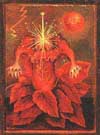 "A bleeding palette" "A bleeding palette"
Teatro delle Donne-Teatro Stabile of Parma
screenplay by Valeria Moretti
direction by Paola Donati
controtenore Maurizio Rippa
The script of this play is a combination of three portraits dedicated to
three women painters coming from different countries and lived in
different times:
Artemisia Gentileschi, from Rome - Italy, Caravaggio follower, lived in
the 1600 Elisabeth Vigée Le Brun, from France, painter at the court in
the 1700; Frida Kahlo, Mexican painter lived in the first half of 1900.
A red wire connects these three women: a triumphant narcisism, an unusual
life marked by a single dramatic event and a suffered artistic research in
extraordinary hystorical times.
For all of them a central topic, a bleeding body: blood of a rape for
Artemisia, blood of the Revolution for Elisabeth, blood of wounds for
Frida. Three different bakgrounds: the Baroque Rome, the French
Revolution, the Zapata's Mexico.
|
"Una
tavolozza rosso sangue"
Teatro delle Donne-Teatro Stabile di Parma
di Valeria Moretti
messa in scena a cura di Paola Donati
controtenore Maurizio Rippa
Il testo si compone di tre "ritratti" ognuno dei quali è
dedicato ad un'artista donna di nazionalità diversa e vissuta in
differenti epoche: Artemisia Gentileschi, romana, caravaggesca, 1600;
Elisabeth Vigée Le Brun, francese, pittrice di corte, fine `700; Frida
Kahlo, messicana, moglie di Diego Rivera, morta nel 1954. Non si vuole
ripercorrere la biografia di queste tre eccezionali figure di donne e di
artiste, ma cogliere un momento preciso della loro esistenza, quasi come
per un autoritratto. Artemisia, al centro di un processo per stupro perchè
violentata da un amico del padre, dipinge Giuditta che scanna Oloferne
caricandola di una voluttuosa e, ancora oggi, insuperata ferocia.
Elisabeth, seducente e ambiziosa riesce a diventare la pittrice prediletta
di Maria Antonietta fissandone il ricordo proprio alla vigilia della
Rivoluzione. Frida, rimasta vittima giovanissima di un pauroso incidente
stradale, segue ostinatamente il tracciato delle sue ossessioni
consegnando allo sguardo altrui, con spavalda ed erotica visione,
l'immagine del suo corpo ferito. Un filo rosso lega queste tre artiste: un
trionfante narcisismo, un'esistenza singolare segnata da un avvenimento
drammatico e una sofferta ricerca artistica al culmine di un momento
storico sensazionale. Per tutte e tre, in primo piano, un corpo macchiato
di sangue: il sangue dello stupro per Artemisia Gentileschi che, da
violentata, nei panni di Giuditta divenne vendicatrice; il sangue della
Rivoluzione per Elisabeth Vigée Le Brun che minaccia e travolge i corpi
perfetti delle sue aristocratiche modelle, il sangue delle ferite per
Frida Kahlo che subisce decine di brutali operazioni chirurgiche. Sullo
sfondo la Roma barocca, la Rivoluzione francese, il Messico di Emiliano
Zapata.
http://www.mclink.it/n/dwpress/dww87c/art1.htm
|
 Multimedia
Frida Kahlo Drama Multimedia
Frida Kahlo Drama
"When Will I Dance? A Play About Frida Kahlo"
The GVSU (Grand Valley State University) Theatre Department will produce
"When Will I Dance? A Play About Frida Kahlo" and include live
classical guitar and slide projections of Kahlo's art. "When Will I
Dance" is set in Coyoacan in the early 1950s and calls for only two
main characters, one who plays the "social, everyday" Frida and
the other portrays the "artistic, spiritual" side of the play's
subject. GVSU senior Theatre majors Elena Garcia and Demetria Thomas will
play the two roles. In addition, two Mexican servants will be played by
GVSU drama students Aaron Hess and Aaron Cope. Garcia has appeared in
Circle Theatre and GVSU productions. Thomas, who has performed major roles
with Mississippi's Warehouse Theatre, makes her GVSU stage debut with this
performance.
During the 75-minute production, concert guitarist Brian Morris will
provide live Mexican and Spanish classical music to accompany scene
transitions and underscore dramatic moments. Ellis has provided for a
visual backdrop by adding projections of Kahlo's paintings and drawings as
well as documentary photos of her and her friends. "When Will I
Dance" author Claire Braz-Valentine will be present for a public
reception in her honor following the November 15th performance.
Braz-Valentine, a frequent lecturer about Frida Kahlo and women's issues,
will also be meeting with GVSU Theatre Arts students during the second
week of performances.
|
Produzione
multimediale su Frida
"When Will I Dance? A Play About Frida Kahlo"
di Claire Braz-Valentine
Il Dipartimento teatrale della Grand Valley State University ha prodotto
questa opera multimediale ispirata a Frida Kahlo, che include
l'accompagnamento di chitarra classica dal vivo e la proiezione su schermo
di alcune opere di Frida. L'opera, ambientata nel Coyocan nei primi anni
'50, è recitata da due personaggi principali: uno rappresenta Frida nel
sociale e nella vita quotidiana mentre l'altro ritrae il lato artistico e
spirituale dell'artista.
La musica di accompagnamento è di stile messicano e spagnolo classico,
mentre lo sfondo propone immagini di quadri e disegni di Frida, oltre a
fotografie della pittrice e dei suoi amici.
|
"Painted
Bread"
a full-length play by Melissa Lucero McCarl, played by Therese Pickard as
Frida Kahlo.
Industrial Arts Theatre at the New Denver Civic Theatre, 721 Santa Fe
Drive CALIFORNIA, February 1997
reviewed at the following page: http://www.westword.com/issues/1997-02-20/theater2.html
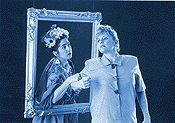
|
"The
Blue Apple"
An interpretive performance based on the life of Frida by Dana Petric.
Further info at her site http://www.interlog.com/~klorker/BLUEsp.htm
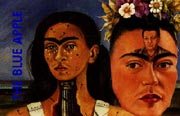
|
(prossimo
articolo torna
all'inizio)
|
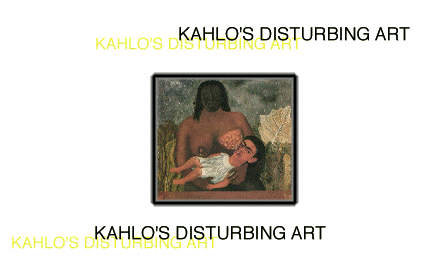
|
All the latest
imagery trends make use of human body: performers, visual artists,
cyberartists, creatives, everybody uncovers bodies, opens bodies, ties
bodies, cuts bodies, paints bodies, tatoos bodies.
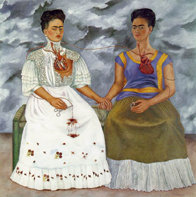 Fragments of bodies are spread everywhere: mere brains in magazines and
tech ads, heads in S/W logos, hearts in Benetton's ads... Fragments of bodies are spread everywhere: mere brains in magazines and
tech ads, heads in S/W logos, hearts in Benetton's ads...
Frida Kahlo made a little bit of all this 60 years ago, showing in her
paintings
·
bloody
births and deaths
·
fetuses
·
corpses
·
disembodied
organs
Other distinctive
features of Frida's works reveal her as a forerunner of modern (or even
better postmodern) extreme cultural tendencies, that explore the same
ground Frida went over with a good deal of courage and anticonformism for
her time:
·
the
vacillating limit between visible and invisible
·
the
strong attraction for transmutation, transformation, mutations of several
kinds
·
invasion
of body by external objects
·
the
breaking of traditional separations such as body/mind, outside/inside.
|
|
Referring to this last point the following quotation from Jacques
Derrida really stroke me when I read it. Derrida's words seem perfectly
correspond to one of the most recurrent aspects of Frida's art: to let the
outside show the inside eliminating phisical barriers such as skin, to
exhibit outside the inside of her life.
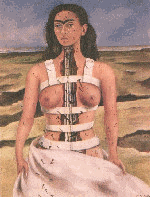 "...
from the invisible inside, where I c "...
from the invisible inside, where I c
taken
from Decostruction on the Net
(torna
all'inizio)
|
|

|

|
|
|
|
|

|
Molti
hanno parlato della mania di Frida per gli autoritratti (circa 1/3 della
sua opera) come di una sorta di terapia per la sopravvivenza, di una
alienazione da sé della sofferenza e del dolore fisico, di una
rimozione dell'azione devastante degli eventi esterni sul suo corpo
(incidente, aborto, operazioni chirurgiche ed altri interventi con
"marchingegni medici" dell'epoca).
Sicuramente Frida ha considerato il suo
corpo al centro di qualsiasi riflessione, sia interna (su se stessa come
donna, artista) che esterna (sugli aspetti culturali, politici e sociali
del suo tempo).
Sicuramente il suo corpo ferito, forato, distorto dalla tecnologia
(tram) e dalle tecniche mediche del tempo era il luogo ideale per una
eliminazione delle barriere tra sé/mondo:
se il mondo esterno ti trapassa con un palo dalle pelvi allo stomaco il
tuo corpo diventa luogo privilegiato di comprensione, di passaggio e
metabolizzazione di qualsiasi evento. Rappresentare il sé diventa
quindi rappresentare il mondo.
Questa rappresentazione non va però interpretata come forma di
idolatria del sé. Nonostante la predilezione di Frida per gli idoli
della religione messicana, spesso presenti nei suoi quadri e soprattutto
nei disegni del Diario, nonostante l'impostazione di molti dei suoi
quadri come "retablos", Frida non
idolatra se stessa perché non si pone come l'immagine del divino, non
c'é in lei tensione mistica verso l'alto, non c'é l'esaltazione della
propria soggettività, né la visione di un ipotetico sé ideale.
Partendo dalla definizione di M. Perniola del feticcio che "non
é il simbolo, né il segno, né la cifra di qualcos'altro, ma vale
unicamente per se stesso , nella sua splendida indipendenza ed autonomia"
possiamo forse azzardare l'ipotesi che Frida sia stata mossa nel
rappresentare (disegnare) se stessa ed il suo corpo da un atteggiamento
profondamente feticista: così il suo corpo cessa di essere un oggetto
identico e fissato nella percezione del soggetto (una forma determinata)
e diventa una sorta di "cosa", acquista una
"straripante" universalità astratta.
Tramite questa interpretazione é possibile comprendere uno dei
paradossi della Kahlo: seppur trafitta e martoriata dal mondo e dalla
malattia, Frida ha sempre mantenuto una grande energia, un sorprendente
dinamismo. Ciò é forse stato possibile proprio grazie al feticismo che
"non adora il mondo, non si fa illusioni su di esso, eppure si
pronuncia senza riserve e con la massima energia a favore di una parte,
di un dettaglio... ".
Ed in realtà Frida ha fatto di vari
dettagli del suo corpo altrettanti feticci, attuando una vera e propria
disgregazione del sé/corpo spargendolo nei suoi quadri e disegni.
La frammentazione é evidente soprattutto nel diario, le cui pagine sono
piene di corpi e parti del corpo disposti in maniera casuale, a volte
abbozzati, semplicemente delineati o creati da macchie, altre volte
immessi in strutture a rete dove mani, piedi, organi genitali e volti si
mescolano. Questo stile é stato spesso letto in chiave surrealista,
secondo la tecnica dell'automatismo delle immagini e parole in libertà.
La stessa Frida lo smentì - "Pensavano che fossi surrealista ma
non lo ero. Non ho mai dipinto sogni. Ho dipinto la mia realtà." -
e ci spinge ad una lettura diversa, dove questa concentrazione quasi
"maniacale" sulla propria realtà diventa un "farsi
cosa", attraverso l'eliminazione della distinzione tra interno ed
esterno del corpo ("Le due Fride", "La colonna
spezzata", "La mia balia ed io"), il confondersi con la
natura, diventando a volte animale ("Il cervo ferito") altre
volte pianta ("Radici"), l' inscrivere se stessa come oggetto
tra gli oggetti ("Ritratto sul confine tra Messico e Stati
Uniti" in cui Frida in abito rosa si erge come una statua tra
oggetti che rappresentano da un lato la tradizione messicana e
dall'altro il paesaggio tecnologico nord-americano).
Attraverso
l'urlo visivo della scritta
YO SOI LA DISINTEGRACION
Frida urla
IO SONO LA COSA UNIVERSALE

My
thanks to Mario Perniola for the hints I took from his book "The
sex-appeal of the inorganic"
(torna
all'inizio)
|
|
![]()